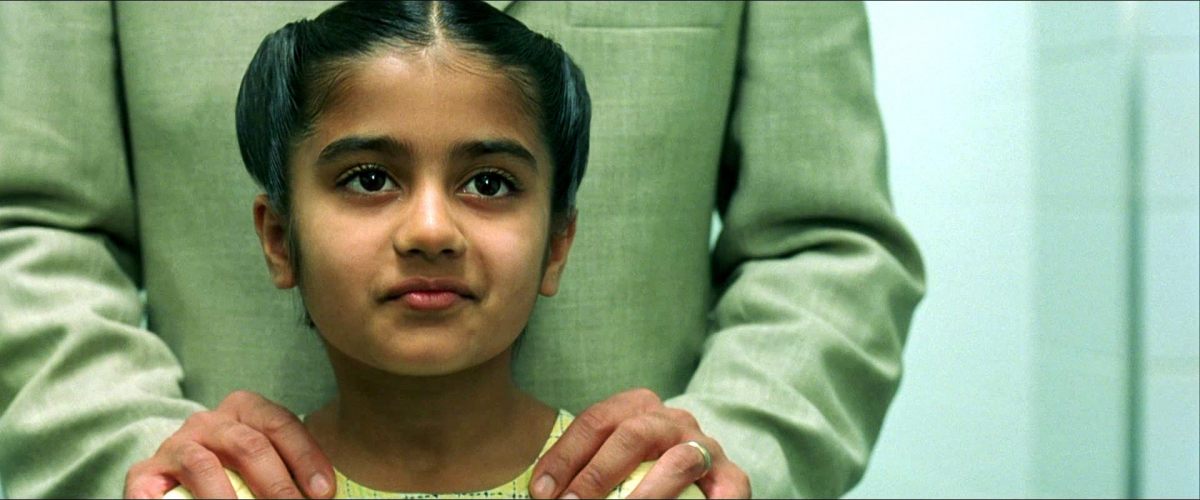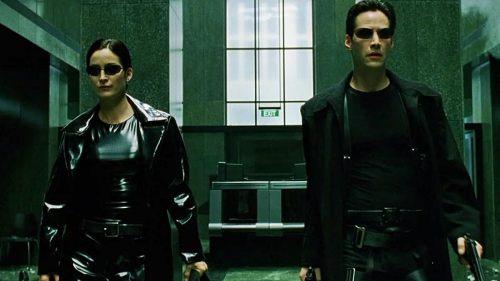THE MATRIX As Transgender Metaphor
“All waking life’s just a living dream” – Laura Jane Grace, Transgender Dysphoria Blues
The greatness of science fiction is in its ability to smuggle political ideals past an unknowing audience. Art is fundamentally the communication of human experience, but audiences who think they’re being preached to are instantly defensive against whatever they think the work is trying to say. When people approach sci-fi however they often assume the science fiction elements are merely what they appear to be. A phallic alien is just a phallic alien, a robot woman imprisoned in a man’s basement is nothing more. This lets authors bypass their audience’s inbuilt prejudices and defense mechanisms, and engage them in an experience they would refuse to consider if they knew what it really was. My favourite example of this is the Matrix trilogy.
The Wachowski Sisters are both transgender, and their genre-defining sci-fi trilogy functions as an extended metaphor for trans people trying to survive in a society that wants to be rid of them. The first film is about a trans woman coming out and asserting her identity, in the face of society’s demands that she stick to its pre-determined ideals of who she is. Aside from never being explicitly described as such, Neo is practically an archetypal trans woman. Every day he puts on a suit and tie and goes to work, but no matter how hard he tries he can’t fit in. He has friends in the counter culture but he doesn’t really connect with them either, and when they go out he stands in a corner staring at beautiful women. Something is always off, always wrong. A splinter in his mind, as Morpheus puts it.
Morpheus wakes him from his dream with a red pill very reminiscent of spironolactone, the most common testosterone suppressant used by trans women, which typically comes as a sunburnt red tablet. After literally rebuilding his body, Morpheus apologises to Neo for the stress he’s going through, telling him they have a rule against freeing people from the Matrix after a certain age. Along with Cypher’s insistence in the film's opening that their attempt to free Neo will kill him, this is a reference to a toxic narrative among trans people, formed by gender-normative society’s continuous pressure to conform to its standards, that you will never be able to truly be the gender you identify as if you transition after puberty.
The main thrust of this analogy, however, is that Neo’s incredibly blunt rebirth-as-your-true-self metaphor is conveyed through his names. His birth name, Thomas Anderson, is used exclusively throughout the film by identically dressed representatives of authority in the forms of his boss and Agent Smith, always addressing him as Mr. Anderson with emphasis on the male pronoun. In contrast, Neo’s friends and allies exclusively refer to him by his chosen name Neo. When Smith interrogates him early on he describes this as Neo having two lives, insisting he must give up the private one as “One of these lives has a future, and one of them does not.”
This finally comes to a head in their confrontation in the underground station, in which Neo finally asserts his identity in the face of death as Smith pins him to the tracks in front of a train. Before he scores his first true victory in the face of authority we get this exchange:
Agent Smith: You hear that Mr. Anderson? That is the sound of inevitability. It is the sound of your death. Goodbye, Mr. Anderson.
Neo: My name is Neo.
Neo’s defeat of Smith in a subway is particularly noteworthy, as in an HRC visibility award acceptance speech Lana Wachowski described almost having committed suicide in her youth over her gender identity by stepping in front of a Chicago L train. Suicide is disproportionately common among trans people, the result of bullying, social ostracisation and many other factors, and Smith here is the embodiment of the cause of all of it. He is the physical manifestation of the pressure to conform to traditional ideals of gender at all costs. The other Agents embody the traditional American square-jawed masculine ideal, but Smith never quite fits this no matter how hard he tries. Part of why Weaving’s performance is so unsettling is that it resides in this sort of gender uncanny valley, outwardly trying to project this kind of masculinity but clearly never embodying it himself. In this way he represents Neo’s resistance to embracing his true identity, the voice in his head telling him there is no future in the way he wants to live, and that he must conform to society's demands of him. But in the end Neo rejects his arguments. He obliterates Smith from the inside, leaving only himself standing where Smith once was.
The sequels then go on to drastically expand this metaphor. Despite Neo's victory over him Smith returns, as sociological systems cannot be defeated that easily, obsessed with destroying Neo and his kind by any means necessary. When the two meet again he greets Neo with this speech:
“We're not here because we're free. We're here because we're not free. There is no escaping reason; no denying purpose. Because as we both know, without purpose, we would not exist. It is purpose that created us. Purpose that connects us. Purpose that pulls us. That guides us. That drives us. It is purpose that defines us. Purpose that binds us. We are here because of you, Mr. Anderson. We're here to take from you what you tried to take from us. Purpose.”
The Agents fundamentally represent the internalization of society’s prejudices, and how they can cause seemingly friendly people to become horrifically violent if they discover you’re someone society deems undesirable. In many places this has even been codified into law, with a legally recognized ‘trans panic’ defence officially allowing panicked, bigoted violence to be considered a legitimate response to finding out someone is transgender. And these laws do not sit gathering dust.
In the sequels Smith’s metaphorical role as Neo’s foil drastically expands as he takes the Agent metaphor to its logical endpoint, embodying the self-destructive nature of these bigotries once they feel threatened and their potential to destroy society (just look at Brexit and Trump). His concept of the world as a defined system, in which everyone has a specific role and purpose, is so rigid and fragile that the existence of people who do not conform to it fills him with terror, and the knowledge that he can no longer fit into it either drives him over the edge.
In this, Smith embodies a psychological defense mechanism called ‘reaction formation’, in which a person attempts to cover up thoughts or feelings they consider unacceptable by acting outwardly in the opposite manner. We see this all the time with homophobic Christian preachers like Ted Haggard who turn out to be secretly gay. Smith ultimately represents a trans woman who has chosen to embrace the false ideal of what society insists she is, and would rather destroy the world than let it remind her of the truth. As Morpheus explained to Neo, Smith is “so inured, so hopelessly dependent on the system, that [he] will fight to protect it.” As the Architect states he's Neo's opposite, what Neo could have become had he taken the blue pill.
Smith’s solution is to force everyone to be more like him through what could be called ‘conversion therapy’, and it’s here when Smith is trying to metaphorically eradicate queerness that the film introduces the character who is the crux of the entire story. This girl:

Sati is a young girl whose parents are trying to hide from the system, as it has decided she doesn’t fit the purpose it assigned to her and will forcibly repurpose her into something it finds acceptable. Does this ring a bell?
Sati is a metaphor for transgender children, who have become a cause célèbre of late because of the achievements made in trans rights in recent years. This is because their relatively widespread acceptance is at the point where bigots can no longer ignore trans people in everyday life, mentally sectioning them off as ‘those weird people we see sometimes on the bus or in Oscar bait movies’. Once their own children are making friends with trans kids or coming out themselves they will be forced to confront how the world no longer agrees with them. That they have lost and will have to let other people be themselves outside of their rigid ideas of what they should be. And this is the happy end-point the Matrix trilogy sees for its characters' struggle. The final scene of Revolutions focuses not on Neo’s sacrifice or the celebrations in Zion, but on Sati finally living without fear as a warm, inviting dawn rises over the Matrix for the first time. Ultimately the heroes of the series are fighting not to make the world better for them, but to make a world in which no-one will have to go through what they did.
The series’ idea of how to improve society is also worth noting. In the end, Neo does not defeat the machines and overthrow the status quo, but instead forces them to accept that the world will be better off if they live in harmony. Because that’s how it works in reality. Trying to replace the existing system with a completely new one from the ground up has a tendency to result in recreating the old system with a new coat of paint, as revolutionaries have internalized the system they grew up in to the point that they have difficulty embracing a genuinely different power structure. Which is why real world civil rights movements instead focus on improving the society they exist within.
Of course there are themes and interpretations of the series unrelated to gender. As Dana Cloud wrote in her essay The Matrix and Critical Theory's Desertion of the Real, the Matrix itself is a literalisation of the Foucauldian idea of power, in which institutional power is a thing distributed among and internalized by all member of society. People only function within hierarchical systems because on at least some level they accept their place within them, fulfilling the purposes they are assigned and protecting the system against threats. After all, it’s only the soldier’s acceptance of his role and position in the army that keeps him obeying orders. This is what Morpheus is describing when he talks about the Matrix as a system of control, a ‘prison of the mind’. Its denizens cannot think outside of their prison, and so not only cannot question it or fight back, but they actively become its agents when its hold over them is threatened. The machines have no visible presence in the Matrix because they don’t need one, their system is self-sustaining with little input required from those who actually control it. And in the end it’s revealed that even rebellion against the system has itself been shaped into a form which perpetuates it.
I really like the Matrix films for being a rare example of genuinely subversive popular art. Almost all popular art is inherently conservative, as it reflects and reinforces the worldview of the majority of audiences. It frequently presents itself as revolutionary, but always either frames itself through the worldview of conservative audiences, as with The Hunger Games, or sanitizes, commodifies and depoliticises the groups and struggles it professes to celebrate, as with Rent and Les Miserables. The Matrix cleverly subverts this however, concealing the struggles of an actual oppressed minority within a thrilling action movie. And audiences all over the world loved every minute of it.
Based on Bootlegging The Matrix by Prof. Ellie Lockhart
Additional input by Arznersfishingrod



